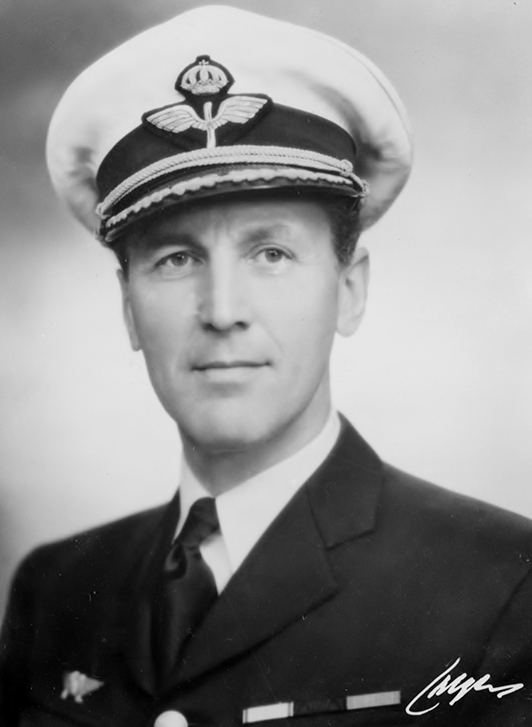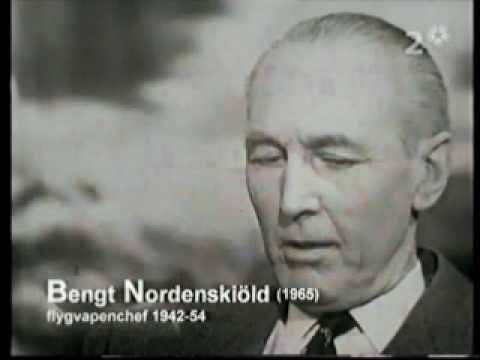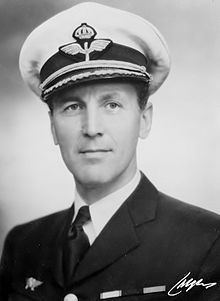Allegiance Sweden Role Friherre (swedish) Name Bengt Nordenskiold | Years of service 1910–1954 | |
 | ||
Born September 6, 1891Sundsvall, Sweden ( 1891-09-06 ) Commands held Air StaffFirst Air SquadronSwedish Air Force Died January 28, 1983, Osterhaninge, Sweden | ||
DC3 juni 1952.wmv
Bengt Gustavsson (G:son) Nordenskiöld (6 September 1891 – 28 January 1983) was a Swedish Air Force general who was Chief of the Air Force from 1942 to 1954. In 1910 Nordenskiöld started his career as a volunteer in the Svea Life Guards (I 1), later attending the Royal Swedish Army Staff College. In 1928, he was made a captain in the General Staff. During 1931 he went through aircraft recognition training at the Royal Air Force Flight Academy, after which he was trained as a pilot. In 1936, Nordenskiöld started work in the recently created Air Staff under General Torsten Friis, later becoming a Lieutenant General. He was appointed in Chief of the Swedish Air Force in 1942. Nordenskiöld was also the first Chief of Air Force with pilot training. He was made a General in 1954.
Contents
Career

Nordenskiöld was born in Sundsvall, Sweden and was the son of managing director, baron Gustaf Henrik Nordenskiöld and Ester Laura (née Andersson). He was a sea cadet from 1907 to 1908 and enlisted as a volunteer at the Svea Life Guards (I 1) in 1910 and became underlöjtnant at the Svea Life Guards in 1912. Nordenskiöld was promoted to lieutenant in 1916 and was educated at the Royal Swedish Army Staff College from 1922 to 1924, where he graduated first in his class in the staff course. He became aa aspirant at the General Staff in 1925 and was promoted to captain and served at Svea Life Guards in 1927 and served at the General Staff in 1928. Nordenskiöld underwent flight training at the Royal Air Force Flight Academy in 1931 and was a teacher at the Royal Swedish Army Staff College in 1933. He became a major at the General Staff in 1934, underwent sergeant pilot training from 1934 to 1936 and was promoted to lieutenant colonel in the Air Force and was appointed Chief of the Air Staff in 1936.

Nordenskiöld was promoted to colonel in 1937 and was appointed became squadron commander in the First Air Group in 1938 before being appointed head of the Royal Swedish Air Force War College in 1939. He was promoted to major general in 1941 - the youngest in modern Swedish history - which received great attention in the media. In 1942 Nordenskiöld was promoted to lieutenant general and appointed Chief of the Air Force. Nordenskiöld was the air force's first pilot trained chief and at the air force wing displays he flew himself sometimes with the J 9 airplane no 19 which come to be his "personal" aircraft. It was with this aircraft he on 18 April 1944 crashed during a start from F 5 Ljungbyhed, where he was badly injured but survived.
When the post of Supreme Commander of the Swedish Armed Forces would be appointed in 1951, Nordenskiöld was one of the candidates that were considered by the government. According to Tage Erlander's diaries, his name was dropped because of his impetuous temper and his propensity to make own foreign policy statements. Instead new Supreme Commander became army general Nils Swedlund. Air Vice Marshal Ralph Cochrane visited Nordenskiöld and the Swedish Air Force 8-13 June 1952. What was discussed during the visit are not known. Cochrane left F 8 Barkarby north of Stockholm in an English Electric Canberra on the morning of 13 June, the same day as a Swedish radio and radar signals intelligence-gathering DC-3 aircraft was shot down by Soviet Air Force fighter jets. Nordenskiöld was promoted to general on 30 April 1954, two months before his retirement.
Other work
Nordenskiöld was chairman of AB Salén & Wicander from 1954 to 1972, Wiklunds bil AB from 1954 to 1972 and AB Godslagring from 1960 to 1972. He was vice chairman of AB Ekensbergs varv from 1955 to 1972, chairman of the board of Skånska cement AB and AB Iföverken from 1939. Nordenskiöld became a member of the Royal Swedish Academy of War Sciences in 1936 (president 1948-49) and became honorary member of the Royal Swedish Society of Naval Sciences in 1954.
Personal life
In 1919, Nordenskiöld married Dagmar Werner (1897–1978), the daughter of the wholesaler Carl Linus Werner and Severina (Inez) Natalia (née Jehander). They had two children, Claes-Henrik Nordenskiöld (1917–2003), who also became an air force general, and Brita Christina (1919–1971) who was married 1940–1948 to Prince Ferdinand Aloys Andreas Joseph Anton Maria of Liechtenstein (1901–1981).
Marie-Louise Elsa Eva Hanna Augusta Lambert-Meuller (1909–1996), the daughter of managing director August Fredrik Lambert Meuller and Elsa (née Flygare), became his second wife in 1934, but the marriage was childless. He was the grandfather of Louise Nordenskiöld and grandfather of Prince Hanno von Liechtenstein.
Nordenskiöld died on 28 January 1983 in Österhaninge and was buried in Southern Cemetery next to Kalmar Castle accompanied by his parents and later his two children.
Dates of rank
Nordenskiöld's dates of rank:
Awards and decorations
Nordenskiöld's awards:
